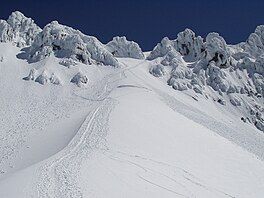Coalman Glacier
| Coalman Glacier | |
|---|---|
 Bergschrund on Coalman Glacier | |
| Type | Mountain glacier |
| Location | Clackamas / Hood River counties, Oregon, U.S. |
| Coordinates | 45°22′19″N 121°41′54″W / 45.37194°N 121.69833°W[1] |
| Area | 20 acres (8.1 ha) |
| Terminus | Talus |
| Status | Retreating |
The Coalman Glacier (also Coleman Glacier) is a glacier located on the upper slopes of Mount Hood in the U.S. state of Oregon. It is the mountain's highest glacier ranging from about 11,200 to 10,500 ft (3,400 to 3,200 m), located within the crater rim, southwest of the peak.[2] It was named for Elija Coalman[3] (variously spelled Elijah Coleman[4]), an early mountain guide who climbed Mount Hood 586 times.[5]

Coalman Glacier is the second most frequently visited glacier on the mountain because it is part of the popular South Climbing route from Timberline Lodge. It lies entirely within Mount Hood Wilderness. The most well known feature of Coalman is the Hogsback: a snow ridge running southwest to northeast from Crater Rock toward the summit ridge. The Bergschrund is another widely known feature where the glacier pulls away from the stagnant ice leaving a large crevasse. In 2007, it had become large enough to cause most climbers to use another route.[6]
The glacier is a remnant of the massive glaciers that formed during the last ice age. It is historically known to change configuration dramatically, at times a gradual, smooth surface to Hot Rocks; at other times the same place has a 40 ft (12 m) ice cliff.[3]
The glacier flows southwest, and is bounded on the north and east by the summit, on the northwest by the rocky crater wall known as Castle Crags (also Hawkins Cliffs), on the west by Hot Rocks, and on southeast by the back side of Steel Cliff.
Climate
[edit]Hawkins Ridge lies on the upper western edge of Coalman Glacier. There is no weather station, but this climate table contains interpolated data.
| Climate data for Hawkins Ridge 45.3703 N, 121.7039 W, Elevation: 9,646 ft (2,940 m) (1991–2020 normals) | |||||||||||||
|---|---|---|---|---|---|---|---|---|---|---|---|---|---|
| Month | Jan | Feb | Mar | Apr | May | Jun | Jul | Aug | Sep | Oct | Nov | Dec | Year |
| Mean daily maximum °F (°C) | 25.1 (−3.8) |
24.4 (−4.2) |
25.3 (−3.7) |
28.9 (−1.7) |
37.6 (3.1) |
44.6 (7.0) |
55.6 (13.1) |
55.9 (13.3) |
50.7 (10.4) |
40.2 (4.6) |
28.5 (−1.9) |
23.9 (−4.5) |
36.7 (2.6) |
| Daily mean °F (°C) | 19.5 (−6.9) |
17.5 (−8.1) |
17.5 (−8.1) |
20.0 (−6.7) |
27.6 (−2.4) |
33.8 (1.0) |
43.3 (6.3) |
43.6 (6.4) |
39.2 (4.0) |
30.8 (−0.7) |
22.4 (−5.3) |
18.5 (−7.5) |
27.8 (−2.3) |
| Mean daily minimum °F (°C) | 14.0 (−10.0) |
10.6 (−11.9) |
9.7 (−12.4) |
11.2 (−11.6) |
17.6 (−8.0) |
23.1 (−4.9) |
31.0 (−0.6) |
31.4 (−0.3) |
27.6 (−2.4) |
21.4 (−5.9) |
16.4 (−8.7) |
13.1 (−10.5) |
18.9 (−7.3) |
| Average precipitation inches (mm) | 16.62 (422) |
12.61 (320) |
13.52 (343) |
10.52 (267) |
7.17 (182) |
5.49 (139) |
1.30 (33) |
1.80 (46) |
4.39 (112) |
10.29 (261) |
16.10 (409) |
18.10 (460) |
117.91 (2,994) |
| Source: PRISM Climate Group[7] | |||||||||||||
See also
[edit]References
[edit]- ^ "Coalman Glacier". Geographic Names Information System. United States Geological Survey, United States Department of the Interior. Retrieved August 5, 2012.
- ^ Mount Hood South, OR (Map). TopoQwest (United States Geological Survey Maps). Retrieved August 5, 2012.
- ^ a b Jack Grauer (July 1975). Mount Hood: A Complete History. self published. p. 291. ISBN 0-930584-01-5.
- ^ Thomas P. Deering, Jr. (July 2, 2004) [1986]. "Mountain Architecture: An Alternative Design Proposal for the Wy'East Day Lodge, Mount Hood Oregon". Retrieved August 16, 2007.
- ^ "1910: Famous Early Mount Hood Climber". Gorge.net. Archived from the original on July 7, 2007. Retrieved August 16, 2007. citing "Legacy". Hood River News.
- ^ Previous noticed posted at "Mount Hood Climbing Report, May 17th". United States Forest Service. Retrieved May 17, 2007.
- ^ "PRISM Climate Group, Oregon State University". PRISM Climate Group, Oregon State University. Retrieved October 5, 2023.
To find the table data on the PRISM website, start by clicking Coordinates (under Location); copy Latitude and Longitude figures from top of table; click Zoom to location; click Precipitation, Minimum temp, Mean temp, Maximum temp; click 30-year normals, 1991-2020; click 800m; click Interpolate grid cell values; click Retrieve Time Series button.

